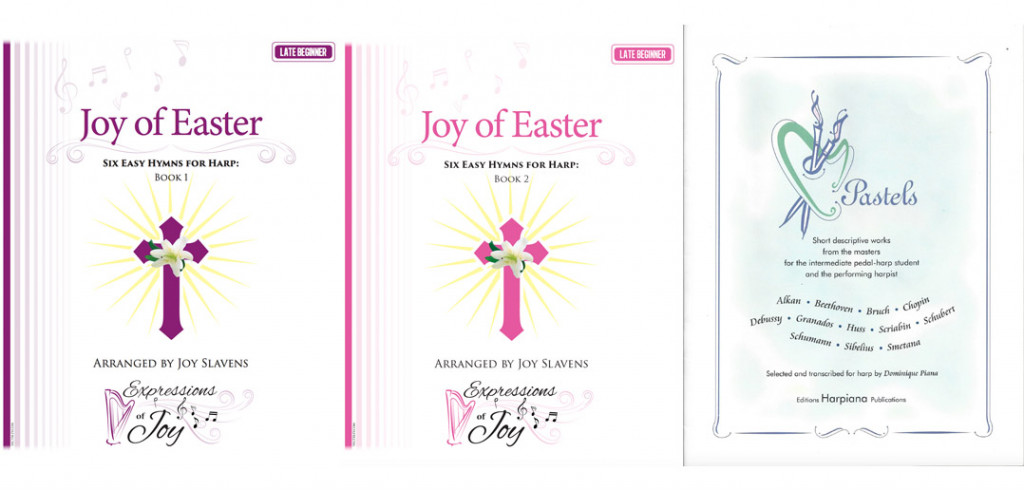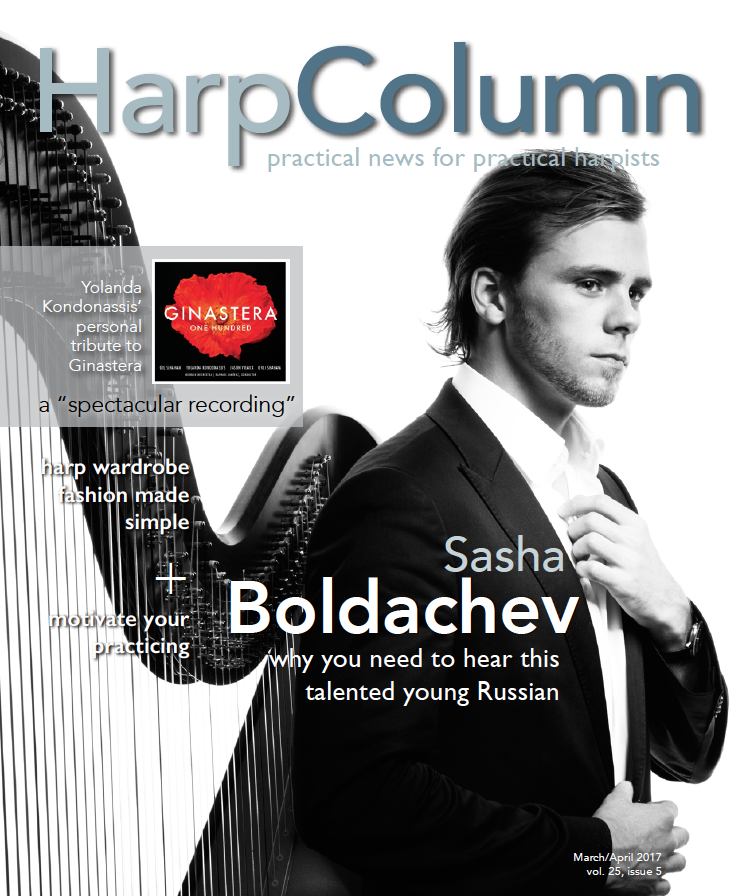
Easter is just around the corner, and there aren’t many books focused on hymns for the season of Lent and Easter. Joy Slavens has published two volumes of hymns for lever or pedal harp, titled Joy of Easter. Each volume contains six hymns suitable for the advanced beginner level.
The music in Book 1 is in the keys of C, F, or B-flat. “My Jesus I Love Thee” incorporates some scale glisses, and the second verse is played up an octave. The second verse of “When I Survey the Wondrous Cross” switches the melody to the left hand. The left hand is slightly more challenging in “Jesus Paid It All” and “There is a Fountain.” The only lever changes within a piece appear in “Christ Arose” and “In the Cross of Christ I Glory.” They are easy and clearly marked with both diamond-shaped notes and pedal markings below the staff.
The first hymn in Book 2, “Near the Cross,” is the only one that requires a page turn and it is well planned. There are a few sixteenth notes for a little more complex rhythm in the introduction, interlude, and ending, as well as a short section with the melody in the left hand. A few suspended chords in “Must Jesus Bear the Cross Alone?” and “The Old Rugged Cross” add harmonic interest. There are several lever changes in the latter piece, but they are manageable. However, a couple of the lever markings aren’t positioned properly on the staff (m. 14 and 15). “At the Cross” has the most variety within the arrangement, as it includes a section with triplets. “In the Garden” has a few manageable lever changes. The final piece, “Hallelujah! What a Saviour!” is short and sweet and is simply played up an octave the second time.
The music in Book 2 is in the keys of G, C, F, B-flat, and E-flat. One thing that could make these collections useful to a wider range of players would be the inclusion of chord symbols above the staff. The arrangements offer enough diversity to make them interesting while still being easy enough for beginners to play without too much difficulty. It’s also convenient to have a source for seasonal hymns.
[pullquote]”…a nice collection that could be used for short recital pieces or to further develop pedal skills and artistry for intermediate players.”[/pullquote]
Pedal harpists should find a new book from Harpiana Publications of interest. Pastels is a collection of 12 short descriptive works from the masters for the intermediate pedal harp student or performing harpist. Dominque Piana has transcribed the pieces and the book is reminiscent of her previous publication, Tendresses (reviewed in the July/August 2006 issue of Harp Column).
The works are arranged in historical order, beginning with “Bagatelle in D Major” (op. 33, no. 6) by Beethoven. It’s the only piece that requires a page turn. Like most of this music, there are a lot of pedal changes, and they are clearly marked either below the staff or in the center. There are some enharmonic substitutions and they are notated by encircling the note to be substituted.
A pretty waltz by Schubert, “Valse Sentimentale” (op. 50, no. 13, D779) follows. Originally written in A Major, Piana has transposed it to A-flat to avoid the modulation to C-sharp major, allowing for richer resonance on the instrument. A sprightly dance, “Phantasietanz” (Albumblatter op. 124, no. 5) by Robert Schumann begins with the left hand starting an accented section in triplets and the right hand playing a chordal pattern of sixteenth notes. Chopin is represented by a “Mazurka in F Major” (op. 68, no. 3). Although the Mazurkas, op. 68, were published posthumously, no. 3 was written when he was a youthful 20-year-old.
In spite of his prolific composing, French composer-pianist Charles-Valentin Alkan isolated himself from society. This selection, “La Vision” (Esquisses 48 Motifs en 4 suites, op. 63, no. 1) requires the player to jump from octave to octave with the accompaniment. There are frequent pedal changes, some enharmonic substitutions, and the conclusion is played prés de la table (p.d.l.t.).
Harpists are familiar with the Moldau by Smetana, but may not be aware he wrote many charming miniatures for the piano. “Píseň (Chanson)” (Album Leaves, op. 2, no. 2) has a single note melody accompanied by ascending arpeggios. At the recap, a harmony note is added below the melody in the right hand.
“Klavierstück” (Piano Pieces, op. 12, no. 4) by Max Bruch has a melody played cantabile and accompanied by a stride bass. Sometimes the melody is played in octaves. There is a p.d.l.t. section, frequent pedal changes, enharmonic substitutions, and fourth finger slides.
“Page d’album” (L. 133) is a waltz by Debussy, composed for a fundraiser during the war. Debussy’s style is unmistakable in this short, beautiful piece.
Henry Holden Huss was a native of New Jersey. After studying in Germany, he became a respected pianist, composer, and teacher in New York City. “Le Crépuscule (Twilight)” (3 Intermezzi, no. 2) features a left hand playing an upward arpeggio pattern.
Sibelius wrote many pieces for piano in addition to his symphonic works. His “Pensée Mélodique” (10 Pensées lyriques, op. 40, no. 6) has an airy melody line accompanied mostly by large, rolled chords. “Preludio” (6 Pieces on Spanish Folksongs) by Granados, begins with large rolled chords that mimic the strumming of a guitar followed by mostly ascending arpeggios for the rest of the piece.
The final piece is a very short work (one page) by Alexander Scriabin, “Prelude in B Major” (3 Pieces, op. 2, no. 2). It is transposed here to C-flat to take advantage of the harp’s fullest resonance.
This is a nice collection that could be used for short recital pieces or to further develop pedal skills and artistry for intermediate players. Ms. Piana has included introductory notes—many shared here—that may be used as program notes or simply to gain insight into the pieces. She has done a wonderful job on this useful assortment of transcriptions. •
Jan Jennings is the music review editor for Harp Column and is the author of The Harpist’s Complete Wedding Guidebook and Effortless Glissing. Email her at mail@harpbiz.com.







